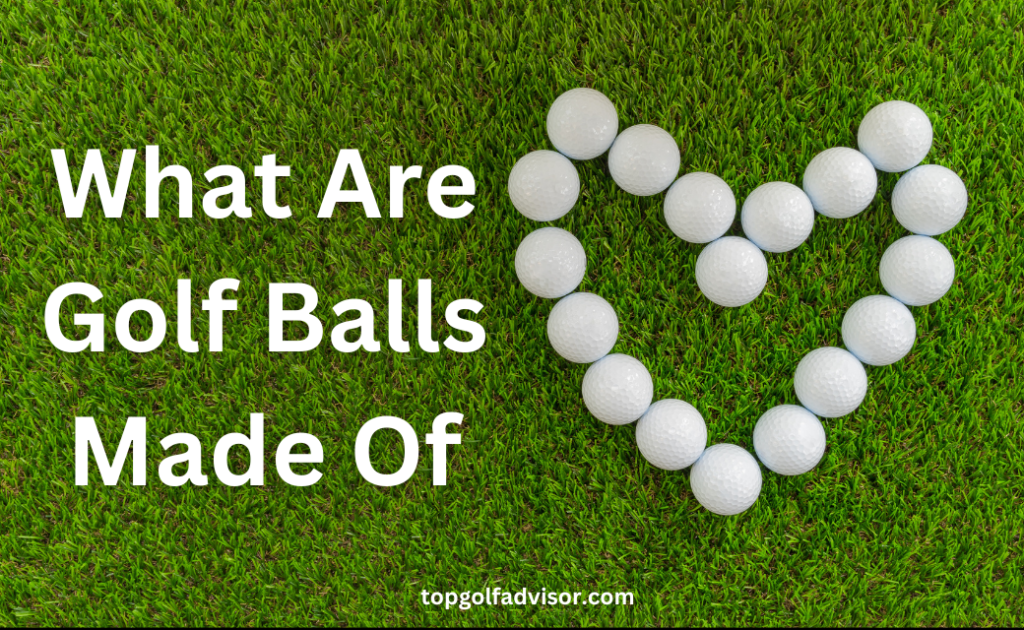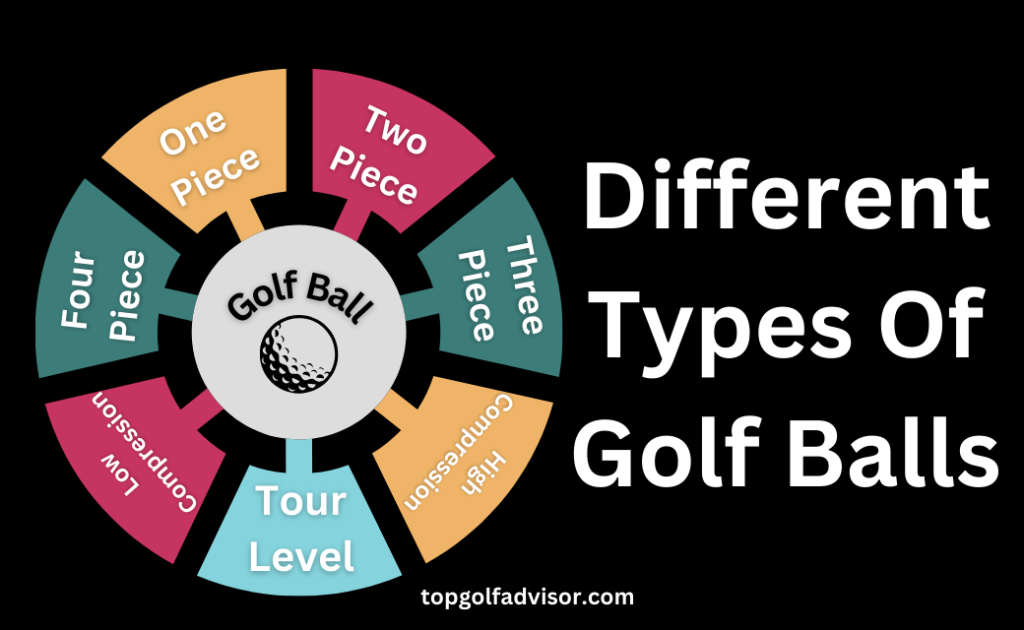Golf balls are a fundamental part of golfing. They may seem simple, small, and cute initially. Still, much thought and precision goes into making these tiny superballs. Therefore, today, we will discuss what are golf balls made of.
You’re not the only one who thinks about the engineering process behind these balls and what makes them fly across an entire football field. Today, we can count on aerodynamics studies, computer simulations, and thermodynamic polymer production. More than 50,000 personalized golf balls are purchased yearly for competitions and outings.
Therefore, if you’re a golfing enthusiast and love to learn more about the sport, stay tuned to learn more fun facts and details about golf balls in this comprehensive guide.

What Are Golf Balls Made Of?
The golf ball primarily comes in a rubber composition. After that, manufacturers cover it with plastic, urethane—an artificial crystalline component also found in pesticides—or Surlyn, a thermoplastic resin.
A golf ball’s design will ultimately differ. The manufacturer and the quantity of parts utilized in the building will determine this.
The core, mantle, and cover are the three primary parts of a modern golf ball. Golf ball makers adjust each component to achieve desired performance characteristics, including improved feel, control, and distance.
You can frequently refer to starting velocity, spin rate, and compression in golf jargon.
What Goes Into The Golf Ball’s Core?
The energy released gets stored in the core upon the golf club’s impact. Historically, these cores were primarily liquid, but contemporary golf ball producers employ synthetic rubbers mixed with polymers.
Right now, the preferred polymer is polybutadiene. Manufacturers want the clubhead to return to its initial form quickly when it crushes the ball. It is the best elasticity.
A company can make a full range of golf balls solely from the materials used in a core, demonstrating how much the precise core structure affects a ball’s performance.
Low-compression golf balls, such as the Callaway SuperSoft and Srixon Soft Feel golf balls, have been making rounds in the market in recent years. These lightweight balls will generally consist of two pieces, and the core needs to be as big as feasible to provide this “soft feel.”
What Are The Different Types Of Golf Balls?
Each golf ball has a unique composition consisting of one to five components. That is a clever way of explaining that each ball has different amounts of layers. Let us scroll through other types and determine what are golf balls made of.
One Piece:
A one-piece golf ball is a simple and basic ball designed for beginners. The primary purpose is for driving ranges, mini-golf courses, or practice. This kind of golf ball comes in one solid piece of material, typically a hard plastic or a synthetic resin with exceptional durability, like Surlyn.
Two-Piece Golf Ball:
Most golfers use a two-piece ball when they play. A second component, typically composed of plastic, encloses the rubber interior. These balls offer an ideal speed limit and are perfect for players with slow speeds.
Three- Piece
A three-piece golf ball’s core consists of solid rubber that wraps in soft plastic. A liquid rubber layer separates the inner and outer layers. Their distance and rotation control blend makes them appropriate for intermediate to advanced players.
Four- Piece Or Multi-Layer Golf Balls:
This kind of ball has a highly soft feel with a urethane cover after the first three coatings consist entirely of rubber. These include several layers, each intended to improve a different performance component, like spin, feel, control, or distance. More experienced players who want power and space off the tee use them.
What Are Golf Balls Made Of: Low Compression Golf Balls:
These are good for players who swing more slowly because of their softer core. Even slower swings can travel more distance because they compress more upon impact.
High-Compression Golf Balls:
These balls are for players who swing the ball faster because of their more complex cores, which compress less when struck. They are more unlikely to inflate in the wind and provide better control.
Tour-Level Golf Balls
Professionals and low handicappers favor these balls because they give maximum spin and control on the greens while keeping distance off the tee. For improved feel and power, they typically feature urethane coverings.
Backspin increases with the number of components on the golf ball. If your club speed is slower, you should stay with a one–, two–, or three-piece construction. You should have more layers on the ball the faster you swing.

How Can You Determine The Speed Of Golf Ball?
You can determine the distance the ball travels by your swing in golf. However, the ball’s structure may also have an impact. The softer golf balls, such as four or five pieces, tend to travel slightly farther, although typically only by five yards.
What Are The Steps To Making A Golf Ball?
Manufacturers use an initial solid chunk of rubber to shape and insert a golf ball into a dimpled ball composed of plastic or urethane. The steps involved in making a golf ball are as follows:
Step 1: Shape a piece of solid rubber into a circular shape.
Step 2: The rubber is injected or compressed into plastic or urethane coverings. At this point, the distinctive dimples are introduced.
Step 3: The covers are painted the desired color and polished. Usually, this is a bright white.
Step 4: The required logo or text, like the maker’s name, is pad printed on each ball.
Step 5: The golf balls are ready for purchase, packaged, and dispatched!
Golf balls require construction with great care. Some of these do make it onto PGA Tours and other elite contests.
Why Is The Golf Ball Design Important?
There is a wide range of golf ball styles since every player is unique. While golf balls are better suited for rapid clubs, some are better for slower swings.
In the end, the golfer makes the decision. Golf is a skill and precision-based game. It all comes down to what suits you best on the course when selecting a ball! Also, check our article on What Is A Four Ball In Golf.
Is There A Possibility Of Golf Balls Going Bad?
Although golf balls don’t spoil, they could lose part of their freshness, much like a baseball bat loses pop and a basketball eventually loses air.
Additionally, you must remember to replace your golf balls because you lose them frequently! Each year, approximately 300 million golf balls disappear from the game. They are everywhere on the fairway, in the shrubs and the water!
Purchasing balls for golf in bulk and keeping them out of extremely cold or hot conditions are good general practices. You can use these balls for many years to come.
Why Do Golf Balls Have Dimples?
Although dimples can add some cuteness to any smile, they are more valuable if it involve golf balls. The ball travels farther and quicker with these tiny indentations than with a perfectly smooth ball.
The dimples lessen the lift and drag. In case you forgot your high school physics class, these are the aerodynamic forces that keep an item moving while it is in the air.
The golf ball’s dimples allow air to enter and depart, eventually lowering the drag, or backward pull, on the ball. Consequently, the ball travels farther and higher than it would if fully spherical.
What Are Golf Covers Made Of?
Despite all the fireworks produced inside, no part of the golf ball’s manufacturing works longer than the cover.
The cover needs to be as rigid as possible to travel those great distances and maximize the energy created within. It must be flexible, though, or it will break quickly.
Surlyn is a primary choice for three-piece balls because it generates more spin (control). An inert substance called urethane gets molded incredibly thin to avoid obstructing velocity (distance).
Wrapping It Up!
What are golf balls made of is a common query among fresh golfers. The idea of how manufacturers construct these impressive balls is a wonder in itself. Therefore, this blog helped clarify this concept and shed light on the essential factors and materials involved in the process.
Check out Top Golf Advisor for the latest updates, information, and entertaining blogs.
FAQs
What does it cost to make a golf ball?
A golf ball costs $0.20, which we predict to increase by 10% annually. The cost of the material necessary to make a golf ball is $0.08 and might increase by 2% annually.
What is the inside of a golf ball called?
The solid rubber center that makes up the ball’s inner core, or first layer, is primarily made to provide distance when using a driver. The ball’s subsequent inner cover layer aims to transmit strike energy to the heated core.
How many golf balls does a golfer need?
However, it doesn’t take a genius to figure out that playing a round with fewer than three golf balls is not the best idea. Indeed, there will be days when you hit every green and every fairway. However, occasionally carrying three to four extra balls in your bag acts as a subliminal safety net.
